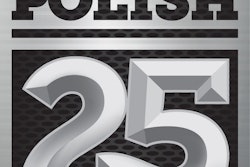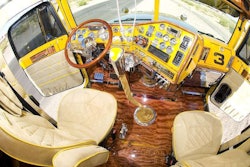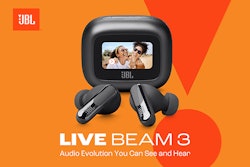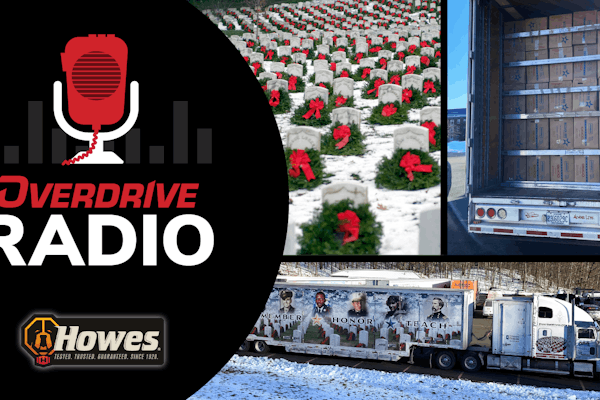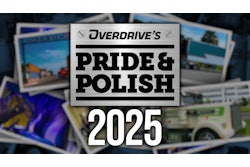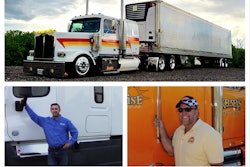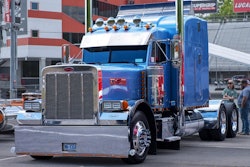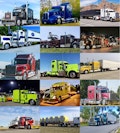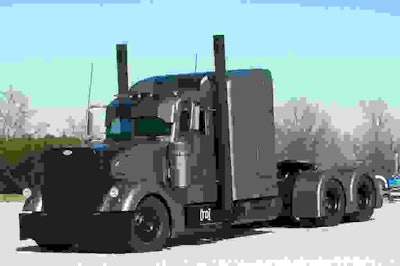 Though to a more extreme extent than many, Outlaw Customs’ blacked-out 2003 Peterbilt 379, dubbed Vigilante, demonstrates how competitors moved to painted parts over chrome and stainless options.
Though to a more extreme extent than many, Outlaw Customs’ blacked-out 2003 Peterbilt 379, dubbed Vigilante, demonstrates how competitors moved to painted parts over chrome and stainless options.Like fashion, car trends and home decor, show truck trends haven’t stopped evolving since truck customizing began its rise in the late 1980s and early ’90s.
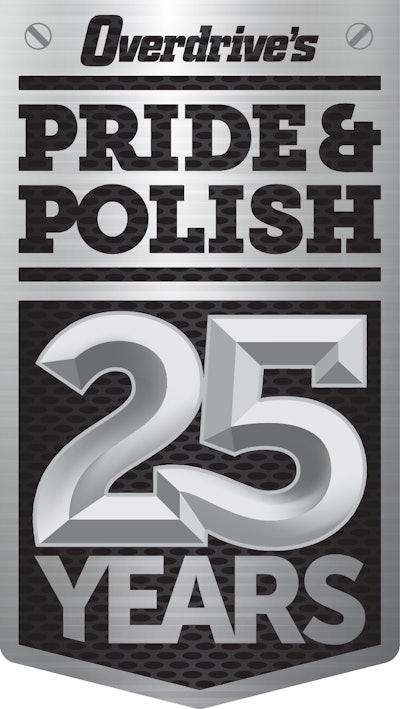 Pride & Polish celebrates its 25th season this year. To celebrate, Overdrive will feature special coverage throughout 2015.
Pride & Polish celebrates its 25th season this year. To celebrate, Overdrive will feature special coverage throughout 2015.Back then, buildup options were limited, says Suzanne Stempinski, a current Pride & Polish show organizer but a longtime owner-operator and Pride & Polish competitor.
Custom and chrome were hard to find, and the trucks on the circuit in many ways paled in comparison to the mega-custom rigs competing in today’s Pride & Polish shows.
Stempinski and a few of the early Pride & Polish competitors even had a parts sharing program, loaning custom parts to one another for competitions while the other would send his or her parts away to be chromed. “It was like a rotating supply,” she says. “It was nuts.”
Bryan Martin, head of 4 States Trucks in Joplin, Mo., has seen nearly all of the show truck trends unfold in the last quarter-century. “In the mid ’80s, people were just bolting on what was available,” Martin says. “If you had a cab and sleeper panels, a drop visor, an air cleaner and a few lights, you had a custom rig.”
Overdrive’s Pride & Polish – which not only provided the opportunity for custom truck builders to show off their work, but also served as a forum for custom ideas to breed – played a big role in driving the evolution of custom truck builds from simple bolt-ons to today’s modern show-stoppers.
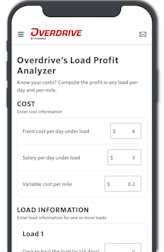
The premier show truck beauty competition celebrates its 25th anniversary this year.
The first Pride & Polish show took place in 1990 in Louisville, Ky. Murals were popular then and through the early ’90s, Martin says. “Like ‘Smokey and the Bandit,’ ” he says. “A lot of desert and Western themes, patriotic airbrushing, things like that.”
 Murals and airbrush painting, as seen here in Overdrive’s May 1994 issue covering that year’s Louisville Pride & Polish event, were popular in the early days of show trucks.
Murals and airbrush painting, as seen here in Overdrive’s May 1994 issue covering that year’s Louisville Pride & Polish event, were popular in the early days of show trucks.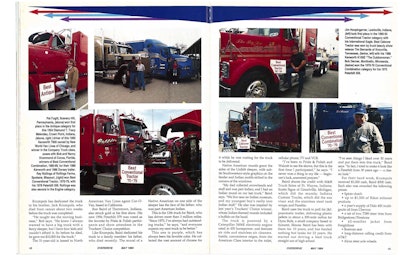
On its heels came one of the more prominent and longer-lasting trends: Lots of chrome and stainless. “People started going for the air horns and the big 6-inch stacks,” Martin says.
Darrian Stephens, who picked up more Best of Shows in that decade than any other Pride & Polish competitor, remembers the chrome generation well. He hung plenty of chrome on his 1995 Freightliner Classic XL, taking cues from the show cars of the day.
“I was always a chrome person,” Stephens says. “I like what [the cars] did, but I think we ended up getting to that level and surpassing it,” he says.
In the mid to late ’90s, lights also exploded, Martin says. Custom truck owners hung lights wherever they could, with trailer lights being a go-to for both show and working truck owners.
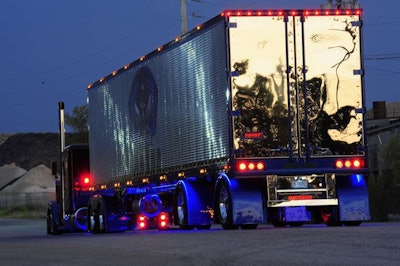 Paul Voigt’s 1999 Peterbilt 379 and 2004 Great Dane reefer sport lots of lights – a popular trend among Pride & Polish competitors in the mid- and late ’90s.
Paul Voigt’s 1999 Peterbilt 379 and 2004 Great Dane reefer sport lots of lights – a popular trend among Pride & Polish competitors in the mid- and late ’90s.Also popular in the mid- to late ’90s were striped paint jobs, Martin says, like those that came stock on Peterbilt and Kenworth models in the ’70s.
At the turn of the century, the game changed again, with lights and stainless losing their luster. Painted components, stretched frames and low front ends took their place.
“People always want to see what they can do to take the crown,” says Stephens. “We were always trying to design and come up with stuff to try to do things different. Somebody would come in with something different – the right touch – and somebody else would say ‘I like that. That’s what I need to do to compete.’ We all get inspired from shows, and that’s how it evolved.”
 John O’Keefe’s 2007 Peterbilt 379, while taking cues from nearly all of the trends in the last 25 years, represents well the modern take on show trucks: Ground-up builds with themes that all parts are designed to show. This truck won the Pride & Polish National Championship in 2012. Elaborate builds with loads of one-off fabricated parts remain popular today.
John O’Keefe’s 2007 Peterbilt 379, while taking cues from nearly all of the trends in the last 25 years, represents well the modern take on show trucks: Ground-up builds with themes that all parts are designed to show. This truck won the Pride & Polish National Championship in 2012. Elaborate builds with loads of one-off fabricated parts remain popular today.Martin marks this era as the one that accelerated both the interest and the innovation of custom truck design. “Around 2000, the bar just got raised,” he says. “People started looking at these trucks as a canvas and started really thinking outside the box. I keep thinking that when it comes to custom trucks, everything’s been done. But then there’s something new that comes along.”
Today, retro – looks from the ’70s and ’80s – seems to be making a comeback, says both Martin and Stephens. Smaller visors, striped paint patterns and stainless once again are growing in popularity.
But elements of all of the trends from the last quarter-century continue to hold – some chrome, some lights and lots of paint. Recent years also have seen a rise in wild interiors and an emphasis on one-off parts and metal fabrication.
 Mike Lemley’s 2000 Peterbilt 379, “Cathouse,” won Best of Show at the Great American Trucking Show in 2014. Lemley’s rig has a mix of painted parts – the fenders, drop visor and grille – while still sporting a little chrome on the stacks and front bumper. The clean lines of Lemley’s rig play well on the Pride & Polish circuit today.
Mike Lemley’s 2000 Peterbilt 379, “Cathouse,” won Best of Show at the Great American Trucking Show in 2014. Lemley’s rig has a mix of painted parts – the fenders, drop visor and grille – while still sporting a little chrome on the stacks and front bumper. The clean lines of Lemley’s rig play well on the Pride & Polish circuit today.“We’re doing things now that 15 years ago we would have thought were nuts,” Martin says. “Rear light bars, T-bars, Frenched-in lights, sculpted and molded metal and bodywork, four- or five-step paint jobs.”
Stephens sees originality and one-off parts continuing to be the trend. “Uniqueness, tedious detailing and cleaning – that’s the stuff that sets a lot of people apart. I just see more of that coming.”




